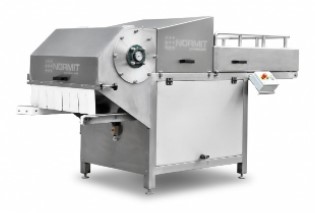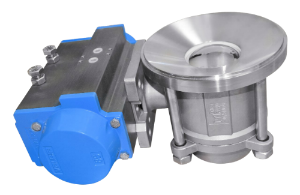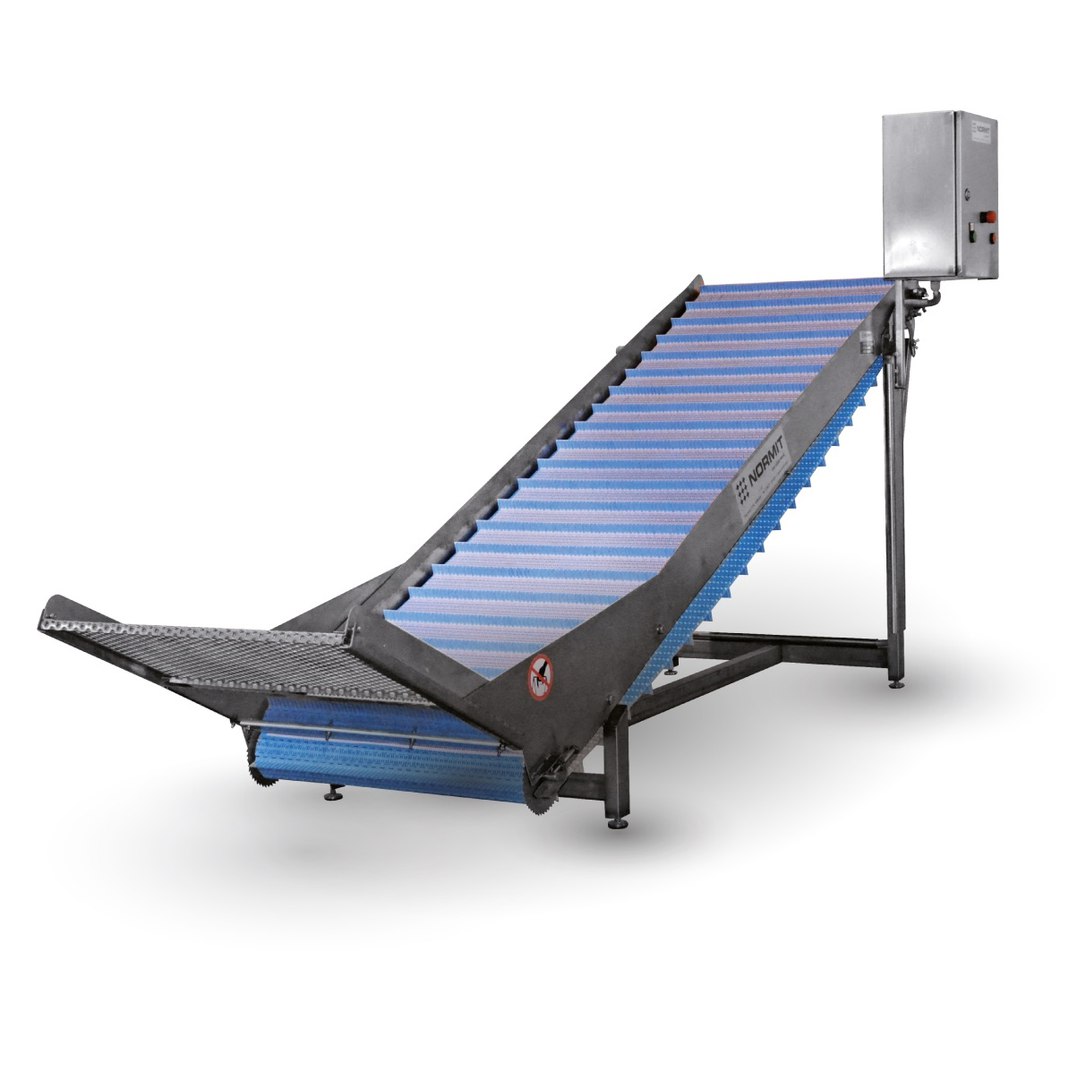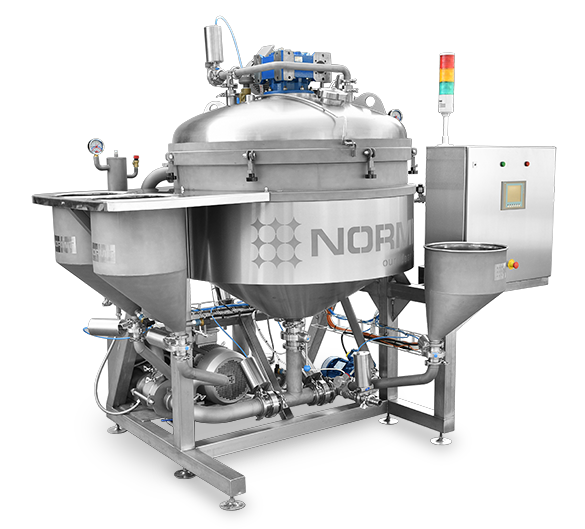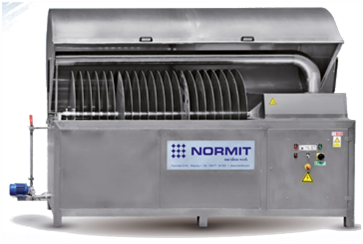Tube heat exchanger
Heat exchangers are used to transfer heat wherever it is not possible to transfer heat directly from the source to the appliance. This might include, for example. heat treatment - heating water, antifreeze
Normit exchanger - tubular has the great advantage compared with other exchanger. Combines with the usual principles of heat transfer, as well as unique features, such as efficient heat transfer for complex products.
Uses
Tubular heat exchangers are used for heat and thermochemical processes between the various types of liquids, gases - (not modified). Heat exchangers may be used as radiators, condensers,evaporators etc.
Products
- Margarine
- Toppings
- Cream

- Marinades
- Peanut Butter
- Animal and vegetable fats
- Spreads
- The soft butter
- Jams
- Chocolate
- Caramel
- Ketchup
- Mayonnaise
- Fillings
- Whipped
- Pudding
- Baby Food

Cosmetics products
- Yogurt
- Confectionery products
Processes:
- Heat
- Heating
- Aseptic cooling
- Deep cooling
- Crystallization
- Dissolution
- Sterilization
- Pasteurization
- Polymerization
- Consolidation
Operating principle 
The product is transferred into the barrel through the heat exchanger tubes from the bottom tangentially upwards. At the same time the hot / cold liquid is delivered to the system transferred in the counter in narrow annular channels. Rotational scrapers deducted product inside and outside the cylinder wall, which provides a uniform heat load of the system.
Improving the efficiency of heat transfer is reached by increasing the speed of hot / cold cooling liquid. The product yield goes through the upper tube. To achieve requested product quality and performance,rotor speed may vary.
Controlling
Can be provided in two ways:
- Manual control is designed for simpler machines and technological equipment, which the technological process is not complicated and therefore do not require complicated programming. It is simple operation by using the ON / OFF button.
- with an automatic control (PLC), which is designed for more sophisticated machines, equipment and production lines, where is necessary to record the temperature, the temperature sensing, alarm the limit parameters, capture multiple variables, the automatic dosing, level control, time setting, monitoring etc.. In the automatic control may be copied records to a PC, there is also the ability to connect and touch screen or connect to Ethernet.
Description
The tubular heat exchangers consist of a bundle of tubes, placed in the tube, from boards, in sheats, tubes and supports. Piping and the space of tubes are separated in these facilities, each from each other and each of them can be divided by partitions into several parts.
Area with heat units can range from hundreds to several cm2 to the several thousand m2. It means that the condenser of steam turbine of 150 MW consists from 17,000 tubes with a total heating surface is about 9000 meters2
A wide range of heat exchangers NORMIT allows to choose such a heat exchanger that meet the requirements of any production process.

Advantages of tubular heat exchangers:

- Reliability
- High efficiency
- Density
- Wide range of applications
- Quick and highly efficient product handling
- Effective heat transfer with continuous scratching the surface. Continuity of process eliminates burnt or freezing
- Large area of heat in a small space
- Careful handling with the product, which eliminates damage
- Easy Maintenance
- Quick and easy to change wipers
- High hygiene - completely eliminate hard-to-reach areas
- Can be combined with CIP washing
- Inspection and maintenance without removing the heat exchanger
- The lid can be opened with clamps
- Tangential inlet
- Acceleration and deceleration
- Lower costs compared to similar models
- Highest quality materials: All parts are made of stainless steel of the highest quality
- Also operates at high temperature
- Reliable operation
- Safety
- Minimum Product Lost
Specifications:
- Single phase flow, the hot and cold side heat exchanger with vertical or horizontal installation
- Pressure range from vacuum to high values
- Different possibilities of pressure on both sides of the large number of options
- Satisfy of requirements of heat, without having to significantly increase the costs of facility
- Size from small to large heat exchangers (5,000 m 2)
- Possibility of using different materials in accordance with the requirements for cost, corrosion, temperature and pressure
- Use of advanced heat transfer surfaces inside and outside the tube, various promoters, etc.
- Ability to extract pipe cleaning and repair


Variants of heat exchangers:
Sheath-tube heat exchangers are those, wherein the tube is welded from one or more steel sheets. Boxes vary primarily associated uses lids and tubes. Wall thickness of the box is determined by the pressure of the working environment and the diameter of the box, but not less than 4 mm. The edges welded cylindrical flanges are connected to the lid or bottom. The outer surface of the sheath forms a support device.
Piping heaters are straight or curved (U-shaped or W-shaped) in diameters of 12-57 mm. Preferred are seamless steel tubes.
The boiler-heat exchanger is flow area of sheath 2-3 times higher than the flow area inside the pipes. Therefore, when the liquid is equal to the phase flow of heat transfer coefficients on the surface are low, which reduces the coefficient of thermal units. Device in sheath and pipe of exchanger increases the cooling rate and heat transfer efficiency.
Types of heat exchangers:

Sheath and tubular heat exchangers may be solid or semi a solid construction, one-way and multi-pass, flow, against the jet, in horizontal, oblique or vertical.
In the single flow exchanger with straight pipes are rigid structure of sheath, tubes are attached to the pipes and there is no possibility of replacing the thermal elongation. These devices are simple, but can only be used for relatively small temperature differences between the body and the tube bundles (50 ° C)They have lower coefficients of heat transfer due to the low cooling speed intertubular area
The boiler heat exchangers flow area is 2-3 times greater than the flow cross-section tubes. Therefore, at the same flow rate of water have the same physical state, the heat transfer coefficient on the surface of the ring are low, reducing the coefficient of heat transfer in the device. Intertubular device in space increases the rate of cooling liquid and increases the coefficient of heat transfer .
The liquid heat exchanger the steam is typically placed in interbular space and fluid in a pipeline. The temperature difference between tube and the pipes are usually significant. For compensation of the difference of thermal expansion is between the sleeve and the piping installed lens gasket and dilatation compensator.
For elimination of tension in metal, due to thermal expansion the single-chamber pipes exchangers are curved in the U-shaped, W-shaped. They are suitable for high pressure cooling liquid in the manufacture of the water chamber and connected by tubes to the pipe at high pressure - operations are complex and expensive. However, the manufacturing of this type of device can experience problems with the production of pipes with different bending radii and problems with the replacement pipe which is bent.
Compensation devices are heavy (membrane, bellows with curved pipes), or are not sufficiently reliable to be used (lens, gasket). Rigid structure of the heat exchanger tube and the free movement of the second plate with a lid inside the pipe is better. Structure with an increase in the average case and adding more lower parts is more reliable in operation. These devices are called heat exchangers "tube in tube".
Heat exchangers with cross-flow and at the same time a high coefficient of of heat transfer on the outer surface causes the cooling liquid moves through a tubular bundle. In the cross flow of is reduced the temperature difference between the cooling liquid, but with a sufficient difference compared with tubes a small bulkhead. For some types of heat exchangers are used tubes with transversal ribs, because of the gas flow in the space between the tubes and increase the heat transfer coefficient.














